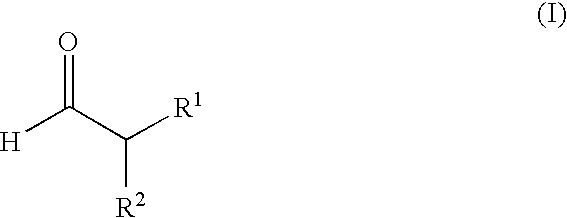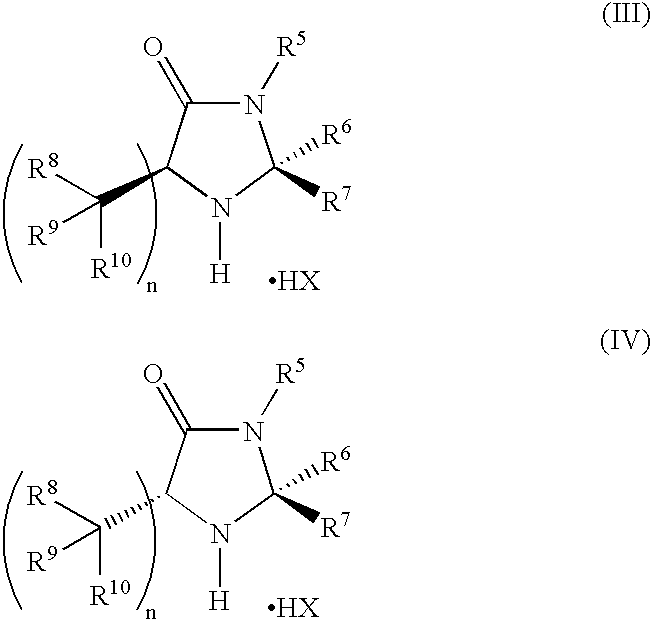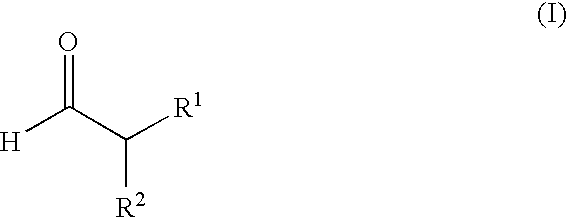Enantioselective alpha-fluorination of aldehydes using chiral organic catalysts
a technology of chiral organic catalysts and aldehydes, which is applied in the preparation of carbonyl compounds, organic chemistry, chemistry apparatus and processes, etc., can solve the problems of failure of the method of halogenating aldehydes and ketones with bromine, chlorine and iodine, and achieve the effect of reducing the number of enantioselective reactions
- Summary
- Abstract
- Description
- Claims
- Application Information
AI Technical Summary
Benefits of technology
Problems solved by technology
Method used
Image
Examples
example 1
[0078] (R)-2-Fluoro-1-undecanol (Table 2, entry 1): Prepared according to the general procedure from undecanal (411 μL, 2.00 mmol) to afford a colorless oil. Purification on silica gel (10-50% Et2O / Pentanes) afforded (R)-2-fluoro-1-undecanol as a colorless solid (261 mg, 70% yield, 94% ee). IR (film) 3271 3171, 2954, 2914, 2848, 1470, 1071, 842.7 cm−1; 1H NMR (300 MHz, CDCl3). 4.56 (dm, J=46.8 Hz, 1H, FCH), 3.59-3.77 (m, 2H, OCH2), 1.89 (s, 1H, —OH), 1.20-1.78 (m, 16H, (CH2)8), 0.88 (t, J=6.9 Hz, 3H, CH3); 13C NMR (75 MHz, CDCl3) ; 96.3 (d, J=166.3 Hz), 65.1 (d, J=21.3 Hz), 31.9, 30.9 (d, J=20.3 Hz), 29.5, 29.4 (d, J=3 Hz), 29.3, 24.9, 24.9, 22.7, 14.1. 19F NMR (282 MHz, CDCl3) : −189.6 (m). HRMS (EI+) exact mass calculated for [M−H]+(C11H22FO) requires m / z 189.1655, found m / z 189.1660. [α]D=7.6 (c=1.0, CHCl3). ([α]D=−8.6 (c=2.0, Et2O) for (S)-2-fluoro-1-decanol and [α]D=−7.2 (c=2.0, Et2O) for (S)-2-fluoro-1-dodecanol (Nohira et al., Japanese Patent No. 62093248 (1987)). Enantio...
example 2
[0079] (R)-2-Fluoroundec-10-en-1-ol (Table 2, entry 2): Prepared according to the general procedure from undec-10-enal (416 μL, 2.00 mmol) to afford a colorless oil. Purification on Davisil® silica gel (10-20% EtOAc / Pentanes) afforded (R)-2-fluoroundec-10-en-1-ol as a colorless solid (296 mg, 79% yield, 94% ee). IR (film) 3214, 2918, 2848, 1641, 1460, 1348, 1073, 990.7, 914.2, 837.8, 806.0, 757.8, 724.4, 668.1 cm−1; 1H NMR (300 MHz, CDCl3). 5.74-5.87 (m, 1H, CH2CH═CH2), 4.90-5.03 (m, 2H, CH2CH═CH2), 4.57(dm, 1H, J=50.7 Hz, FCH); 3.60-3.80 (m, 2H, OCH2), 2.03 (q, 2H, J=14.1, and 7.5 Hz, CH2CH═CH2), 1.83 (t, 1H, J=6.6 Hz, —OH), 1.26-1.76 (m, 12H, FCH(CH2)6); 13C NMR (75 MHz, CDCl3) δ; 139.1, 114.2, 94.8 (d, J=166.5 Hz), 65.1 (d, J=21.8 Hz), 31.7, 30.9 (d, J=20.0 Hz), 29.3, 29.3, 29.0, 28.8, 24.9 (d, J=3 Hz). 19F NMR (282 MHz, CDCl3) δ: −189.6 (m). HRMS (EI+) exact mass calculated for [M+•]+ (C1H21FO) requires m / z 188.1576, found m / z 188.1575. [α]D=8.1 (c=1.0, CHCl3). Enantiopurit...
example 3
[0080] (R)-(Z)-2-Fluorodec-7-en-1-ol (Table 2, entry 3): Prepared according to the general procedure from (Z)-dec-7-enal (366 μL, 2.00 mmol) to afford a yellow oil. Purification on silica gel (5-20% EtOAc / Pentanes) afforded (R)-(Z)-2-fluorodec-7-en-1-ol as a pale yellow liquid (283 mg, 81% yield, 94% ee). IR (film) 3369, 3006, 2935, 2861, 1462, 1376, 1172, 1056, 843.1 cm−; 1H NMR (300 MHz, CDCl3) 5.26-5.42 (m, 2H, CH2CH═HCCH2), 4.56 (dm, 1H, J=50.5 Hz, FCH), 3.62-3.76 (m, 2H, OCH2), 1.98-2.10 (m, 4H, CH2CH═HCCH2), δ 1.89 (t, 1H, J=6.4 Hz, —OH), 1.32-1.74 (m, 6H, CFH(CH2)3), 0.95 (t, 3H, J=7.4 Hz, CH3); 13C NMR (75 MHz, CDCl3) δ: 132.0, 128.7, 94.7 (d, J=166.5 Hz), 65.1 (d, J=21.3 Hz), 30.9 (d, J=20.0 Hz), 29.5, 26.8, 24.5 (d, J=5.0 Hz), 20.5, 14.3. 19F NMR (282 MHz, CDCl3) δ: −189.6 (m). HRMS (EI+) exact mass calculated for [M+•]+ (C10H19FO) requires m / z 174.1420, found m / z 174.1421. [α]D=5.6 (c=1.0, CHCl3). Enantiopurity was determined by chiral HPLC analysis of the 2-naphtho...
PUM
| Property | Measurement | Unit |
|---|---|---|
| Fraction | aaaaa | aaaaa |
| Fraction | aaaaa | aaaaa |
| Fraction | aaaaa | aaaaa |
Abstract
Description
Claims
Application Information
 Login to View More
Login to View More - R&D
- Intellectual Property
- Life Sciences
- Materials
- Tech Scout
- Unparalleled Data Quality
- Higher Quality Content
- 60% Fewer Hallucinations
Browse by: Latest US Patents, China's latest patents, Technical Efficacy Thesaurus, Application Domain, Technology Topic, Popular Technical Reports.
© 2025 PatSnap. All rights reserved.Legal|Privacy policy|Modern Slavery Act Transparency Statement|Sitemap|About US| Contact US: help@patsnap.com



